Scottish Transport Statistics No 29: 2010 Edition
Has figures on (e.g.) road vehicles, traffic, accidents, bus and rail passengers, road and rail freight, air and water transport, finance, personal travel and international comparisons.
SUMMARY TRANSPORT STATISTICS INCLUDING HISTORICAL SERIES
Figure 1: Vehicles licensed
millions
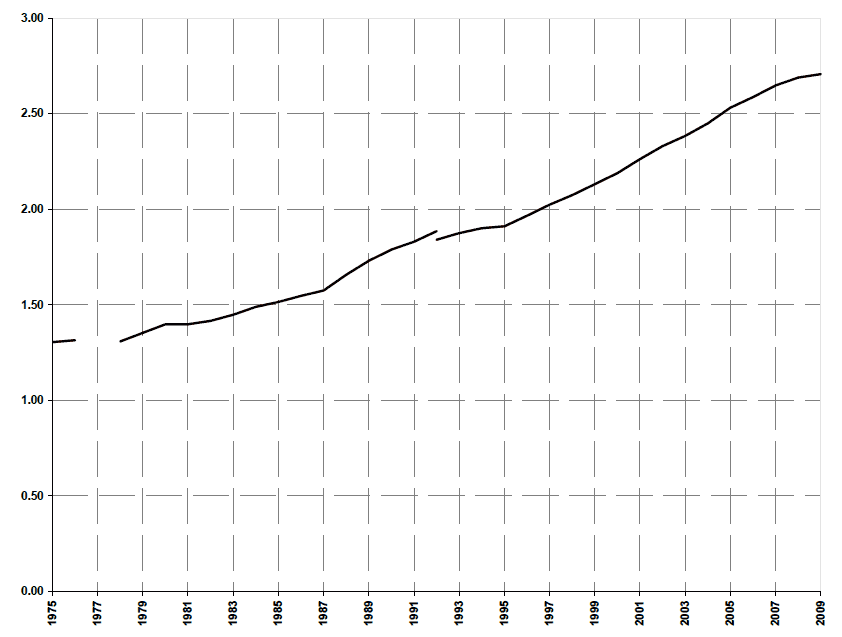
NB: breaks exist in the series due to changes in the collection method. In 1978 collection moved from local taxation offices to the DVLA (annual vehicle census) while figures from 1993 onwards originate from the DfT Vehicle Information Database
Figure 2: New registrations of vehicles
thousands
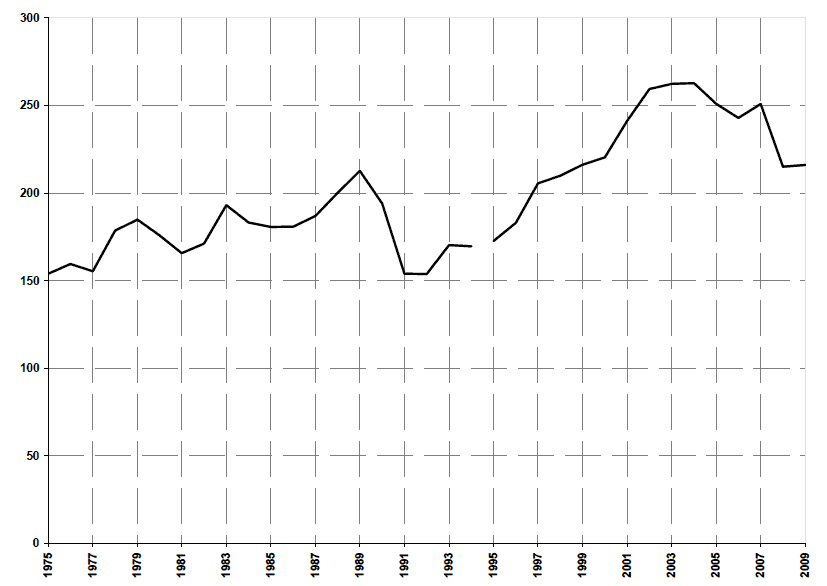
NB: a break in the series exists in 1994. Results prior to this are taken from DVLA geographical analysis. Results for 1995 onwards are estimated using post town area data.
SUMMARY TRANSPORT STATISTICS
1. Introduction
1.1 This chapter provides some main points from the statistics on transport in Scotland, and some comparisons with the figures for Great Britain (or the UK as a whole).
2. The content of this chapter
2.1 The summary is arranged as follows:
- section 3 - motor vehicles, the road network, traffic, toll bridges and road casualties;
- section 4 - public transport (bus, rail, air and ferry);
- section 5 - personal travel (possession of driving licences; frequency of driving, walking and cycling; travel to work and travel to school);
- section 6 - freight;
- section 7 - cross-border transport;
- section 8 - notes, sources and further information
Comparisons with the figures for GB/ UK are included within sections 3 to 6.
2.2 The charts show some of the main trends in transport in Scotland since 1975, and some comparisons with GB over the past ten years. The tables, which appear at the end of the chapter, provide:
- a summary of the trends for each mode of transport in Scotland over the past ten years - Tables S1 and S2;
- a summary of the main trends shown by the Scottish Household Survey - Table S3;
- a summary of cross-border transport for some different modes over the past ten years - Table S4;
- a comparison of some key figures for Scotland and Great Britain (or, in a few cases, the UK as a whole) - Tables SGB1 to SGB3; and
- a summary of the longer-term trends in passenger and freight transport, traffic estimates and some other vehicle-related statistics, back to 1960 in some cases - Tables H1 to H4.
3. Motor vehicles, traffic and road casualties
3.1 Motor vehicles
3.1.1 The number of motor vehicles licensed in Scotland in 2009 was 2.7 million, 1 per cent more than the previous year, 27 per cent higher than the number in 1999 and the highest figure ever recorded. Over the longer-term, the number of vehicles licensed has increased from an estimated 0.8 million in 1962. Figure 1 shows the trends since 1975: there have been increases in almost every year.
3.1.2 There were around 216,000 new vehicle registrations in Scotland in 2009, an increase of 0.5 per cent on 2008. It was the nineth highest figure ever recorded, the same as 1999 and two and a half times the number (86,000) in 1962. Figure 2 shows that the number of new registrations of vehicles has risen and fallen a number of times during the period since 1975, and that it has been around a quarter of a million per year only within the last five years.
Figure 3: Traffic (vehicle kilometres)
millions
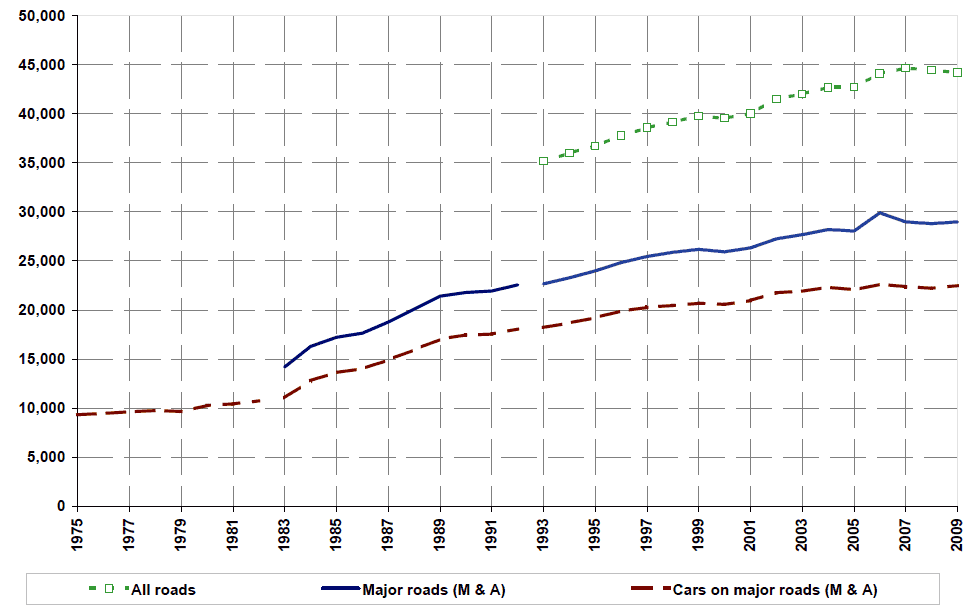
NB: breaks in the series exist as the DfT revised its method of estimating traffic volumes from 1993. Estimates of traffic on minor roads are not available prior to 1993.
Figure 4: Reported road casualties
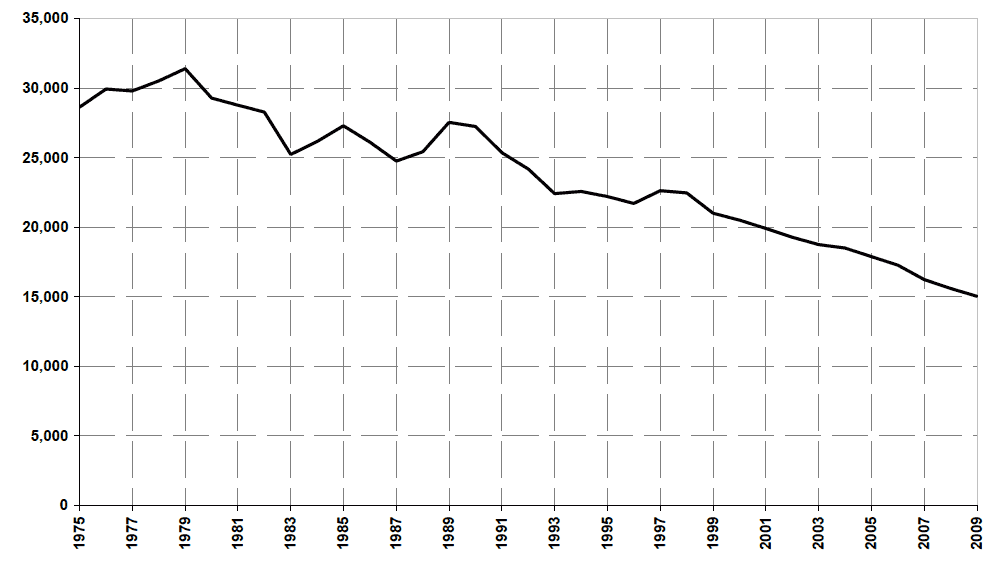
* figures for 2009 are provisional
3.1.3 In 2009, there were 52 vehicles per 100 population in Scotland compared with 57 in Great Britain. Figure 7 shows that the number of vehicles per head of population has been rising steadily, and has been consistently lower in Scotland than in Great Britain.
3.1.4 The Scottish Household Survey ( SHS) shows that, in 2009, 69 per cent of households had at least one car available for private use - up from 63 per cent in 1999. Twenty six per cent of households had two or more cars in 2009, compared with 18 per cent in 1999. As the SHS is a sample survey, its results are subject to apparent year-to-year fluctuations.
3.1.5 2008/09 is the latest year for which one can compare the availability of cars to households in Scotland and GB as a whole, using the results from the National Travel Survey. In 2008/09, around 72 per cent of households in Scotland had the regular use of a car compared to 75 per cent in Great Britain as a whole. Any year-to-year fluctuations, and differences between these results and those of the SHS, are likely to be due to sampling variability.
3.2 The road network
3.2.1 Provisional figures show there were 55,000 kilometres of public road in Scotland in 2009 with the trunk road network accounting for 6 per cent of this. Relative to the size of the population, the length of the road network is greater in Scotland than in Great Britain: in 2009, Scotland had 10.7 kilometres of road per 1,000 population; GB had only 6.6 kilometres per 1,000 population.
3.3 Road traffic
3.3.1 The estimated total volume of traffic on Scotland's roads in 2009 was over 44 billion (thousand million) vehicle kilometres - 0.6 per cent less than 2008 and 11 per cent more than the figure for 1999. The total volume of traffic is at its third highest ever level: the estimates show increases in most of the past ten years apart from 2000, which was affected by the fuel protests and .
3.3.2 The pattern in Scotland was similar to that for Great Britain as a whole. The total volume of traffic for Great Britain fell by 1 per cent between 2008 and 2009, and was 8 per cent higher than ten years earlier, with increases in most years (including a very slight rise in 2000).
3.3.3 Figure 3 shows the longer-term trends in Scotland. It is estimated that the volume of car traffic on major roads (Motorways and A roads) has more than doubled, from an estimated 9,300 million vehicle kilometres in 1975 to around 22,000 million vehicle kilometres in recent years. Figure 3 shows that the main rise was between 1983 and 1995.
3.3.4 Per head of population, there is less traffic on Motorways, more traffic on A roads, and more traffic on all roads taken together (including B, C and unclassified roads) in Scotland than in Great Britain.
Figure 5: Passenger numbers: local bus and rail
millions
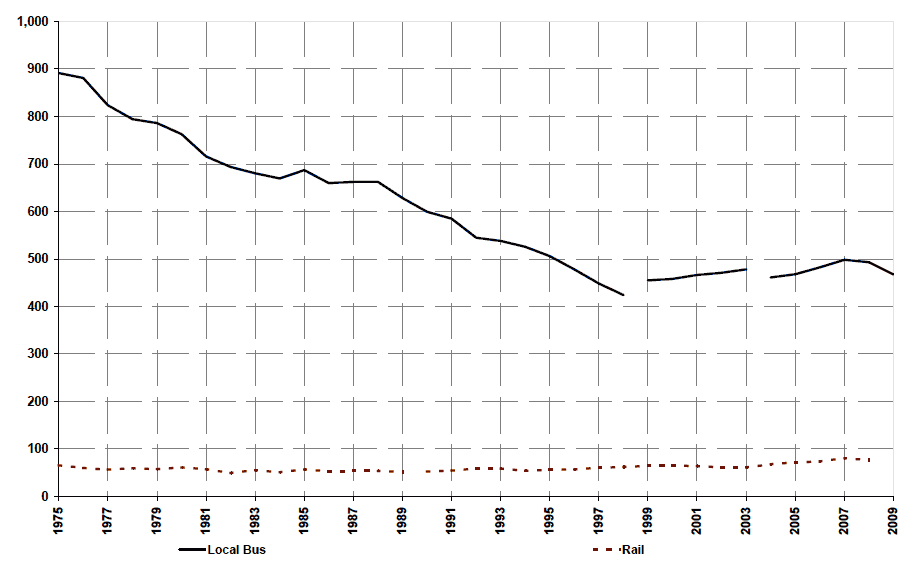
NB: Due to methodological improvements bus figures are not strictly comparable ( prior to 1999/00 and from 2004/05 onwards).
Rail figures up to 1990/91 were provided by British Rail, but now provided by the Office of Rail Regulation.
Figure 6: Passenger numbers: rail, air and ferry (selected services)
millions
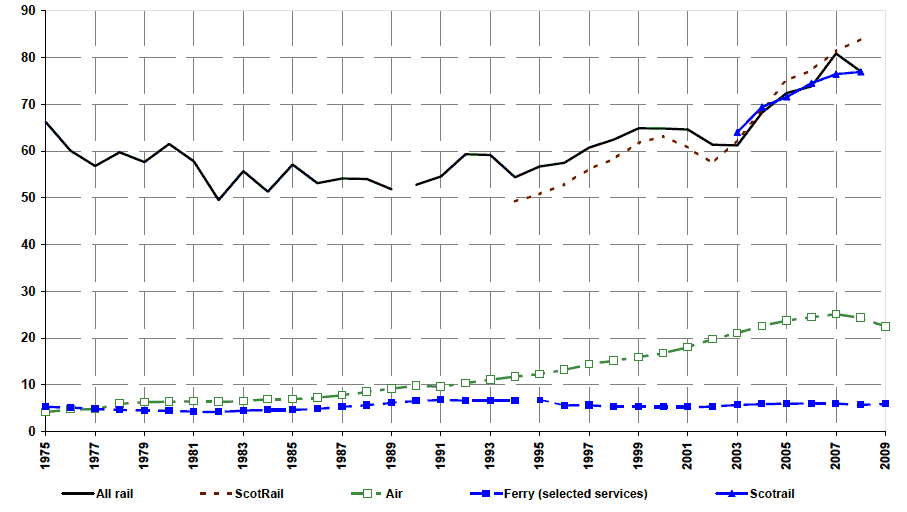
NB: First ScotRail took over the franchise in 2003, therefore earlier do not exist. Rail figures prior to 1990/91 were provided by British Rail.
Rail figures up to 1990/91 were provided by British Rail, but now provided by the Office of Rail Regulation.
The Skye bridge opened in 1995 and may impact on ferry patronage figures.
3.4 Road casualties
3.4.1 The number of road deaths in Scotland in 2009 (216) was 20 per cent less than in 2008, and the lowest figure since current records began over 50 years ago. 2,269 people were seriously injured in road accidents in 2009, 12 per cent less than in 2008, and the lowest figure recorded. Over the past ten years, the number of people injured in road accidents fell by 28 per cent to 15,030 in 2009. Figure 4 shows that there have been falls in most years since 1979. Although in some years the drop appeared to be levelling off, over the longer-term the number of casualties injured in road accidents has fallen steadily.
3.4.2 Since 1999, the number of people killed or seriously injured in road accidents has fallen by the same percentage (39%) in Scotland as in Great Britain. The number of people killed or seriously injured per thousand population was slightly higher in Scotland than Great Britain in 2008 (about 0.48 and 0.43 respectively).
4. Public transport: bus, rail and air and ferry
4.1 Local bus services
4.1.1 In the 2009-10 financial year there were 467 million passenger journeys on local bus services in Scotland, a decrease over the previous year of 5.3 per cent.
4.1.2 However, over the longer-term, there have been large falls. There were almost 1,700 million passenger journeys on local bus services in 1960. The number had almost halved by 1975. Since then, it has roughly halved again, from 891 million in 1975 to 467 million in 2009-10. There were falls in every year between 1960 and 1999 except 1985, 1987 and 1988. Figure 3 shows the trends since 1975; it and Figure 4 show that local bus passenger numbers are much higher than other modes of public transport.
4.2 Rail passenger services
4.2.1 There were 76.9 million ScotRail passenger journeys recorded in 2009-10, 0.5 million (0.7%) more than in the previous year, and an increase of 20% since 2004-05.
4.2.2 Over the longer-term, the number of rail passenger journeys originating in Scotland (including cross-border journeys) fell from a peak of 73 million in 1964 to a low of 50 million in 1982. Figure 6 shows that, from 1982 until 1996-97, passenger numbers remained between 50 million and 60 million per year. Latterly, rail patronage had been rising since 1994-95 and reached almost 65 million in 1999-00, but then fell to just over 61 million in 2002-03, before rising again to 84.5 million in 2008-09 (based on ORR data, see chapter for details).
4.3 Air passengers
4.3.1 There were around 22.5 million air terminal passengers at airports in Scotland in 2009, the sixth largest number ever recorded: 8 per cent less than in the previous year, and 41 per cent more than in 1999. Figure 6 shows the rise since 1975. Over the longer-term, terminal passenger numbers grew from 1.2 million in 1960 to 22.5 million in 2009.
Figure 7: Vehicles licensed per 100 population
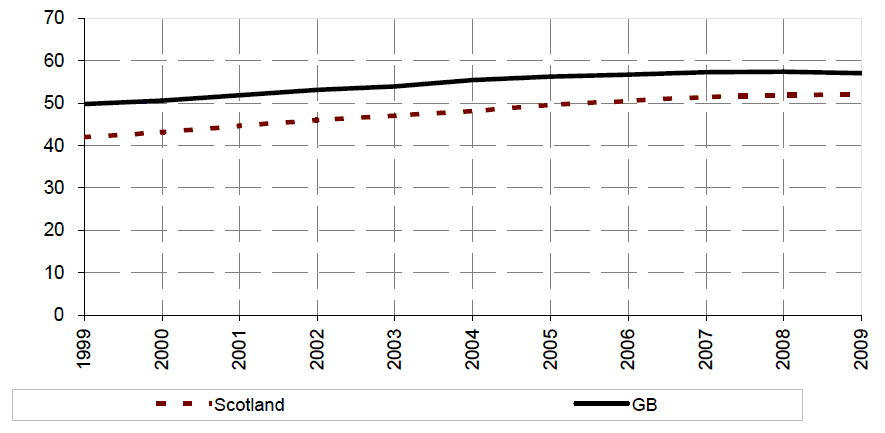
Figure 8: Passenger numbers per head of population: local bus and rail
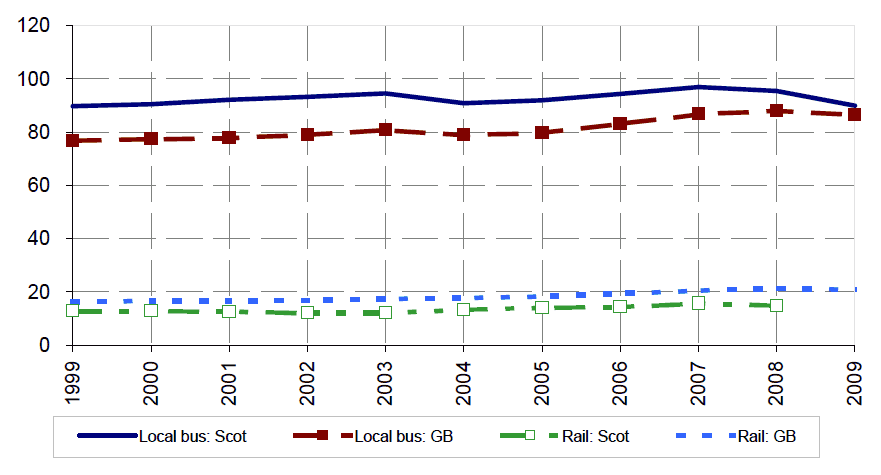
Figure 9: Passenger numbers per head of population: rail and air
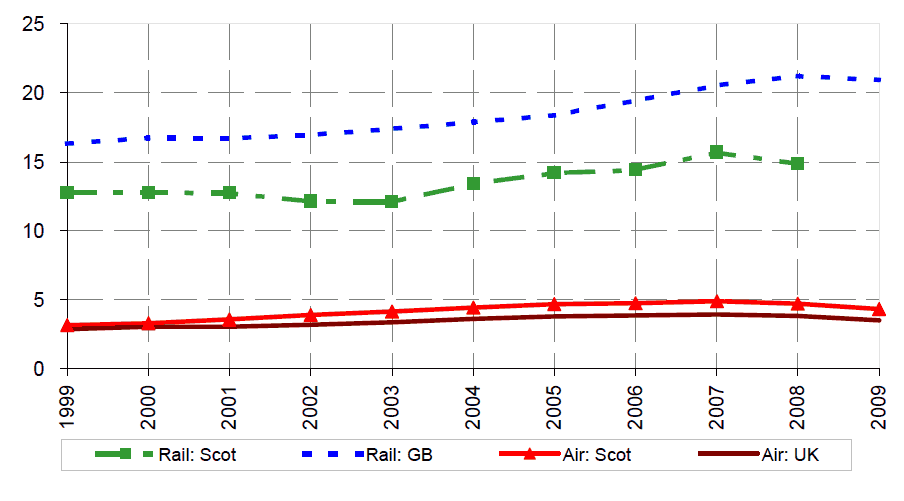
4.3.2 Between 1999 and 2009, the number of air terminal passengers increased by 41 per cent for Scotland and 30 per cent for the UK as a whole. Over the past ten years, the number of passengers per head of population has been higher for Scotland than for the UK.
4.4 Ferry services
4.4.1 In 2009, 6 million passengers were carried on those shipping services within Scotland for which figures are available back to 1973 (i.e. Caledonian MacBrayne, P&O Scottish Ferries / NorthLink Orkney and Shetland, and Orkney Ferries). This was 4 per cent more than in the previous year. Figure 6 shows the long-term trends, which were affected by the reduction in traffic that followed the opening of the Skye Bridge in 1995.
5. Personal travel (e.g. driving, walking and cycling; travel to work and school)
5.1 Possession of driving licences, and frequency of driving
5.1.1 68 per cent of people aged 17 or over had a full driving licence in 2009: 76 per cent of men and 61 per cent of women. Since 1999, the proportion of men who have a driving licence has remained steady at almost three-quarters, whereas the percentage of women aged 17+ who have a full driving licence has increased nine percentage points since 1999. As a sample survey, the SHS's results are subject to sampling variability.
5.1.2 In 2009, 43 per cent of people aged 17+ said that they drove every day. The percentages who said that they drove at least 3 times a week (but not every day) rose from 8 per cent in 1999 to 12 per cent in 2009.
5.2 Frequency of walking
5.2.1 Respondents were asked on how many of the previous seven days they walked more than a quarter of a mile (a) in order to go somewhere (i.e. used walking as a means of transport), and (b) for pleasure or to keep fit, including walking a dog. In 2009, 59 per cent of individuals reported walking to go somewhere on at least one of the previous seven days and 48 per cent said they had walked for pleasure or to keep fit. These figures are the highest reported since the survey began in 1999. All survey data should be treated with caution, taking sampling variability in to consideration.
5.3 Travel to work and travel to school
5.3.1 In 2009, over two-thirds of commuters said that they travelled to work by car or van (61% as a driver and 6% as a passenger), 12 per cent walked, 12 per cent went by bus, 4 per cent took a train and 2 per cent cycled. While there have been year-to-year fluctuations in the SHS's results, the percentage driving to work has risen 6 percentage points whereas passengers fell by 5 percentage points.
5.3.2 The Labour Force Survey ( LFS) shows that the percentage of people travelling to work who go by car has tended to be slightly lower in Scotland than in Great Britain as a whole, and the percentage using public transport has tended to be slightly higher in Scotland than in Great Britain. According to the LFS, in Autumn 2009, 70 per cent of people travelling to work in Scotland did so by car, the same as Great Britain and 14 per cent used public transport (compared with 15 per cent for Great Britain). The year-to-year fluctuations, and any differences from the results of the SHS, are likely to be due to sampling variability.
Figure 10: Freight lifted: road and coastwise shipping
million tonnes
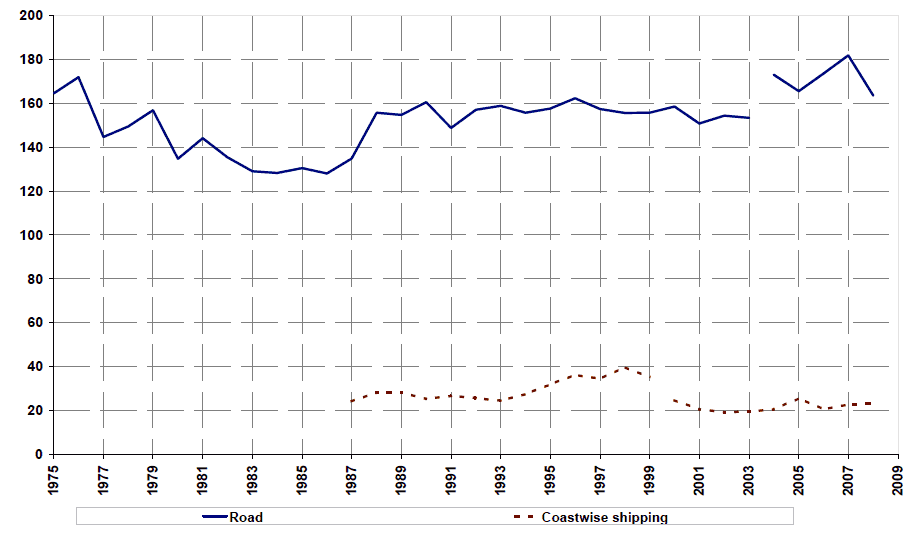
NB: breaks appear in the series due to changes in the survey methodology and processing.
Figure 11: Freight lifted: coastwise shipping, pipelines, inland waterway, rail
million tones
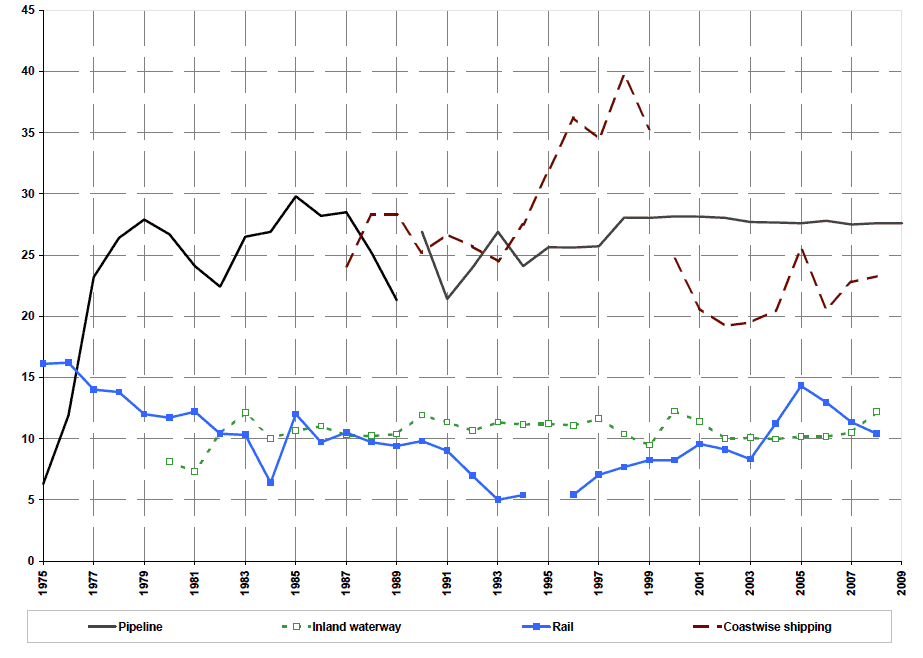
NB: breaks appear in the series due to changes in the survey methodology and processing. The increase in pipeline figures between 1989 and 1990 is believed to be due to a change in coverage.
5.3.3 50 per cent of pupils walked to school in 2009, 22 per cent went by bus, 24 per cent by car, 1 per cent cycled, and 1 per cent went by rail. While there have been year-to-year fluctuations in the results, it appears that, since the SHS started in 1999, the percentage going by car has risen from around 18 per cent.
6. Freight
6.1 Freight lifted - tonnes
6.1.1 Freight lifted by road in Scotland in 2009 was 139 million tonnes. The figures for 2004 onwards should not be compared with the statistics for earlier years because there is a break in the series following changes to DfT's survey methodology and processing. Prior to that, there had been little change from year to year in the ten years up to 2003. Over the longer-term, the amount of freight carried by road fluctuated between 1975 and 1987 (see Figure 10), rising to 172 million tonnes in 1976 and falling to 128 million tonnes in 1986. After 1988, it was more stable, varying between 149 million tonnes (in 1991) and 162 million tonnes (in 1996). The total of 153 million tonnes in 2003 was the third lowest in the period since 1988. Figures 10 and 11 show that, in terms of tonnes lifted, much more freight is carried by road than by any other mode of transport. Per head of population, the amount of freight which is lifted by road is slightly higher in Scotland than in Great Britain.
6.1.2 The volume of rail freight traffic lifted in Scotland fell from 29.8 million tonnes in 1960 to 5.4 million tonnes in 1994-95. Figure 11 shows that since then it has increased in most years, and stood at 10 million tonnes in 2008-09.
6.1.3 Coastwise freight traffic lifted in Scotland rose from 24 million tonnes in 1987 to 40 million tonnes in 1998. Since then, the total has fallen to around 19-23 million tonnes in five of the latest six years (the figure for 2005 appears unusual). However, the figures from 2000 are on a different basis from those for earlier years (see Chapter 10). The annual amount of freight lifted for inland waterways has remained between about 9 and 12 million tonnes since 1982. Figure 11 shows the trends since 1980 (inland waterway) and 1987 (coastwise traffic). Per head of population, much more freight is lifted by coastwise shipping in Scotland than in Great Britain.
6.1.4 The amount of oil carried in Scottish pipelines rose rapidly to 23 million tonnes in 1977, and has fluctuated since then between 21 million tonnes and 30 million tonnes per year. Figure 11 shows the trends since 1975. Per head of population, the amount of freight which is lifted by pipeline is significantly greater in Scotland than in Great Britain.
6.2 Freight moved - tonne-kilometres
6.2.1 Figures 10 and 11 showed that, in terms of tonnes lifted, much more freight is carried by road than by any other mode of transport. However, a different picture can be seen when account is taken of the distance that freight is carried. Table H2(b) shows that, in terms of tonne-kilometres, coastwise shipping accounted for the largest amount of freight moved in most years, with road coming second (in 2004 the position was reversed). Rail and pipeline still move smaller amounts of freight than road. However, they represent a higher proportion of the total for road freight when they are measured in tonne-kilometres, because of the greater distance (on average) for which freight is carried by rail and by pipeline.
7. Cross-border transport
7.1 Table S4 summarises the information about cross-border transport which is available from national statistical systems. Their coverage is incomplete - for example, they have no figures for the number of cross-border journeys made by car, bus or coach (estimates of these are produced by the Transport Model for Scotland - see Chapter 12).
7.2 Passengers to / from other parts of UK: In 2008, there were 20.1 million rail, air or ferry passenger journeys between Scotland and other parts of the UK (a return trip counts as two passenger journeys). Compared with 1999, when there were only 17.2 million such passenger journeys, this was an increase of 17 per cent. Since 1999, the number of passenger journeys by air has increased by 20 per cent, compared with relatively little change in rail and ferry numbers.
7.3 Passenger journeys to / from other countries: In 2009, there were 9.77 million passenger journeys to or from Scotland to other countries, almost all by air. This was a slightly down on 2008, when there were 10.43 million passenger journeys. The number of passenger journeys has almost doubled from 1999 when the figure was 5.43 million.
7.4 Freight to / from other parts of UK: In 2008, 37.6 million tonnes of freight were lifted by either road, rail or water and delivered to other parts of the UK. This was a decrease of 9 per cent over 2007 when 41.1 millions of tonnes of freight were lifted. Freight delivered to Scotland from other parts of the UK in 2008 was 25.6 million tonnes. This was a decrease of 15 per cent on 2007 when 30.0 million tonnes were delivered.
7.5 Freight to / from other countries: In 2008, 43.4 million tonnes of freight were delivered outside the UK, almost all of which was carried by water. This was a decrease of 7 per cent on 2007 when 46.7 million tonnes of freight were lifted. Freight delivered to Scotland from outside the UK in 2008 was 16.8 million tonnes, again almost all by water transport - an increase of 10 per cent (15.3 million tonnes in 2007).
8. Notes, Sources and Further Information - historical
8.1 In general, notes, definitions and sources appear in the relevant chapters. Information here relates to historical trends.
8.2 Occasionally, figures given for Great Britain (or the UK) are on a different basis from the figures for Scotland. Such differences in the bases of the figures for Scotland and GB/ UK should not prevent their use in a broad comparison of the trends.
8.3 Motor vehicles, the road network, traffic, toll bridges and road casualties
8.3.1 Vehicles Licensed: ( Chapter 1). The figures for 1962 to 1974 represented the numbers of licences current at any time during the third quarter. They were derived from an annual census which used the records held by local licensing authorities. The method underlying the census then changed as vehicle records were gradually transferred from local taxation offices to the Driver and Vehicle Licensing Centre. Consequently, the figures for 1974 to 1978 are not comparable. No census results were available for 1977. Censuses based entirely on the record of licensed vehicles at the Driver and Vehicle Licensing Agency ( DVLA) began on 31 December 1978 and subsequent counts were taken on the last day of each year up to and including 31 December 1992.
Thereafter, the source of this information changed to the Vehicle Information Database ( VID) held by what is now the Department for Transport ( DfT). The results conform to the same definitions as earlier vehicle censuses, but, for technical reasons, are considered slightly more reliable than earlier estimates. Some vehicles have complicated licensing histories that may include incidents such as cheques failing to clear, changes of taxation status, late payments, and one or more valid or invalid refund claims. The VID undertakes a more detailed examination of licensing history than earlier vehicle census analyses and is therefore able to provide better estimates of licensed stock. The net effect of the change to the VID as the main source of statistics on currently licensed stock was to produce a small reduction in the estimated levels of licensed stock. The difference between the two sources can be broadly estimated from statistics for 1992 which are available from both the old and new sources.
The VID figures for all vehicles licensed at the end of 1992 are 2.4 per cent lower for Scotland, and 3.1 per cent lower for England and Wales, than the DVLA figures for the same date. For example, the VID figure for Scotland for 31 December 1992 is 1,840,000 compared with the DVLA figure of 1,884,000. To estimate the growth in the number of licensed vehicles over the longer term, these changes should be used to adjust the apparent vehicle growths calculated from figures which are on different bases pre- and post-1992.
8.3.2 Car Traffic on major roads:Chapter 5 describes the methods used to estimate the volume of car traffic on major roads in Scotland for 1983 and subsequent years. As those methods cannot be used to estimate car traffic in Scotland for earlier years, the then Scottish Executive had to make ad-hoc estimates for the years from 1975 to 1982. These ad-hoc estimates were calculated using the rate of change in the volume of traffic for Great Britain as a whole, adjusted to take account of changes in the number of vehicles licensed in Scotland relative to the number for Great Britain as a whole. The estimates for 1975 to 1982 therefore indicate the likely level of car traffic on major roads in Scotland in those years, and may well be considerably less accurate than the estimates for later years.
8.4 Public transport (bus, rail, air and ferry)
8.4.1 Bus Passengers:Chapter 2 describes the method used to collect these statistics with effect from the 1985-86 financial year. A different method was used for 1984 and earlier years: the figures for 1975 to 1984 relate to calendar years and, prior to 1986, the term stage services was used (rather than local services). The figures for 1960 to 1974 are on a different basis: they were produced by adding together the total numbers of passenger journeys reported by the Scottish Bus Group (for calendar years) and the four city corporations (for financial years). They therefore include any non-local services run by these operators, and exclude any local (or stage) services that were run by other operators. In addition, it appears that the figures reported by the Glasgow city corporation may have included passenger journeys on trolley buses and on the Glasgow Underground. The method used to collect the data has been changed and data prior to 2004 are not comparable.
8.4.2 Rail Passengers: See Chapter 7. The statistics relate to financial years with effect from 1985-86. The figure for 1984 is derived from a total for the fifteen-month period 1 January 1984 to 31 March 1985, by scaling this down to an estimate for a twelve-month period. The figures for 1983 and earlier years are for calendar years. The figures for 1990-91 and earlier years were provided by British Rail after the end of each year; those for 1991-92 to 1999-2000 were provided by the Association of Train Operating Companies in Spring 2001. See also paragraph 4.2.2 for details of changes to Scotrail methodology.
8.5 Freight
8.5.1 Road Freight:Chapter 3 describes these statistics. There is a small discontinuity between the figures for 1986 and 1987: the former excludes freight whose destination is Northern Ireland, and the latter includes such freight. As Table 3.1 shows, the amount involved is a very small percentage of the total.
8.5.2 Rail Freight: See Chapter 7. The statistics relate to financial years with effect from 1985-86. The figure for 1984 is derived from a total for the fifteen-month period from 1 January 1984 to 31 March 1985, by scaling this down to an estimate for a twelve-month period. The figures for 1983 and earlier years are for calendar years.
8.5.3 Coastal shipping: The figures for Scotland cover freight on coastwise voyages for which either the origin or the destination (or both) is in Scotland - i.e. all coastwise freight lifted in Scotland plus the coastwise freight lifted elsewhere in the UK which is discharged in Scotland. This definition of coastal shipping excludes foreign, one port and inland waterway freight shipping. For historical reasons, the definition used for the coastal shipping series differs from the definitions which are used for the water transport statistics in chapter 9. There is a small discontinuity between 1981 and 1982, due to a change in definitions. The figures were provided by the Department for Transport - Margaret Talbot (Tel: 0207 944 4131).
8.5.4 Coastwise Shipping: See Chapter 9. These figures are lower than the figures for coastal shipping, because the latter includes freight lifted elsewhere in the UK which is discharged in Scotland.
8.5.5 Pipelines: Figures from 1993 onwards estimate the total carried by on-shore pipelines which are at least 50 km in length and which carry crude oil or products. Figures for Scotland relate to pipelines originating in Scotland. Estimates are produced by the Department of Trade and Industry, based on pipeline operators information The estimates were supplied by DTI and Charanjit Ransi (Tel: 0207 215 2718) can provide further information about them.
There is a problem
Thanks for your feedback